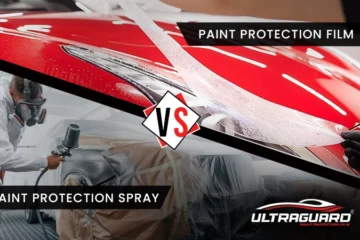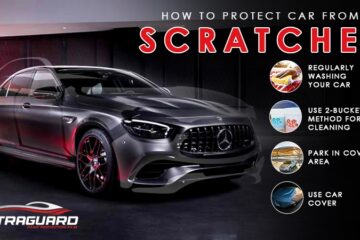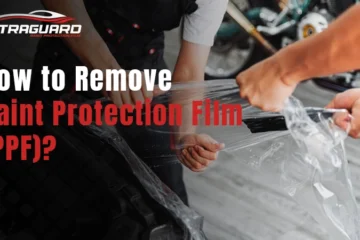If you’re passionate about keeping your car looking as good as new, you’ve probably heard about PPF. But what are paint protection films? This guide will explore PPF benefits, materials used, types and costs. This guide has covered every possible question you might have before considering getting your vehicle PPF protected.
![What Is Paint Protection Film? [A Comprehensive Guide]](https://www.ultraguardindia.com/blog/wp-content/uploads/2024/02/What-is-Paint-Protection-Film.webp)
What is Paint Protection Film?
Paint Protection Films, widely known as PPF, are applied to a vehicle’s painted surface to preserve the paint’s showroom finish.
PPF can be installed on the entire body of the car or to protect high-impacted areas such as the hood, front fenders, front bumper, side view mirrors, rocker panels, the lower portion of the doors, and rear guards behind the rear wheels.
These protective films are self-healing, hydrophobic and absorb other environmental impacts that will damage the paint’s aesthetic. PPF can be installed manually or using pre-cut, which are taken out by specific plotter machines to make a pattern to the shape of the panel the film is being installed on.
What is PPF Film made of?
Three of the most common PPF types available in the market are TPU, TPH, and PVC. Here is how they work:
TPU:
TPU stands for Thermoplastic Polyurethane, the most durable and flexible film used in the detailing market. Every high-quality PPF film is made of TPU.
They give exterior paint protection for up to 10 years or a lifetime (If appropriately maintained). TPU films do not crack or get discolored.
PVC:
PVC stands for polyvinyl chloride, also known as vinyl wraps. It is the earliest and previously most widely used film in the detailing industry.
These films do not have any properties of PPF like self-healing ability or hydrophobic effect. These films tend to lose both their elasticity and color over time.
TPH:
TPH stands for thermoplastic hybrid; it has Polyvinyl Chloride (PVC) as its base. These films are cheaper alternatives to TPU films but are better than PVC films. TPH materials are more flexible than PVC and do not discolor.
Benefits of Paint Protection Film (PPF) for Cars?
If you are a car or a bike owner, we suggest you get your vehicle PPF protected. If you are not sure about the benefits you will get from PPF, keep reading this blog:
1. Maintains Pristine Look:
PPF films work excellently to preserve your vehicle’s sleek and polished look. If your car gets impacted with minor scratches, it will get self-healed. On application of heat by special heat gun or sunlight the minor abrasion will go away.
2. Prevents Discoloration:
Your vehicle’s exterior paint gets discolored with UV rays, mineral contaminants, and other stains. PPF will provide an excellent shield against these elements and prevent paint from getting discolored.
3. Long-lasting Protection:
PPF can protect the paint on a car for up to 10 years, ensuring it looks brand new. But to maintain the efficiency of the PPF, you need to keep the PPF and take it to your detailer for regular check-ups.
4. Preserves Resale Value:
PPF works effectively in maintaining the resale value of the vehicles. When your vehicle’s paint is flawless and looks brand-new after a year of using it, every potential buyer will be willing to pay extra for your car.
5. Saves Extra Money:
Imagine your car gets scratched, and to get rid of it, you have to get it repainted, which will cost you a fortune. If your vehicle is a PPF-protected vehicle that got scratched, you must replace the panel, which is comparatively cheaper.
What Varieties of PPF Are Available in the Market?
PPF films come in various finishes, apart from clear or transparent finishes. Mentioned below are some common types of PPF in the market:
Matte PPF
These films come with a matte or satin finish. They are non-reflective in nature.
Gloss PPF
These transparent films have a high gloss sheen. It will add extra shine to the vehicle’s exterior.
Textured PPF
These are new films introduced with finishes such as carbon fiber, forged carbon fiber and Damascus steel finish.
Coloured PPF
These are like advanced versions of Vinyl wraps but have all the quality of high-grade TPU films.
What is Car PPF Cost?
PPF costs vary depending on factors like car size, film quality, and coverage area. Generally, a complete car PPF installation starts from Rs.75,000. Prices may increase for high-end cars or specialized films. It’s a worthwhile investment to keep your car’s paint looking new and preserve its value. Remember, cheaper options might exist but may not offer the same protection level or quality.
Is it worth investing in paint protection film price?
You might initially feel that the cost of PPF installation is high, however, it will surely pay you back in the long run. In the event that your vehicle gets scratched, this protective layer will eliminate the need for expensive paint repairs. Furthermore, if you are a frequent driver or often drive in areas prone to road debris, you should consider investing in PPF costs. Ultimately, PPF will do wonders in preserving your vehicle’s look, ensuring it remains in top condition for years to come.
The Bottom Line
Cleaning your car isn’t sufficient to maintain the vehicle’s showroom shine; you need to get it protected with paint protection film. If budget is not a constraint, you get a whole-body PPF. Else; you can shield high-impact areas like the hood, bumper, and doors. As a one-time investment, we advise you to opt for high-quality films, as cheaper films might leave gum stains on PPF removal. Doing proper research before choosing the PPF installer would be best, as your detailer must be experienced to give the best results.
Frequently Asked Questions (F.A.Q)
Why is paint protection film so expensive?
PPF films usually cost high as they are made from advanced materials and are thick enough to shield the vehicles from scratches, chips, and sun damage. Also, hiring a professional installer and opting for a branded PPF will add to the cost.
What is PPF wrap durability?
PPF wrap is known for its durability. Usually, a good quality PPF can last between 5 to 10 years. This lifespan depends on things like the quality of the film, how much the car is exposed to harsh weather, and how well you take care of it.
When to Remove Paint Protection Film?
If the film starts showing signs of wear and tear, like yellowing, cracking, peeling, or bubbling, it is time to remove and replace the PPF from the affected panel. Also, if it gets scratched, you should replace it. PPF should only be removed by professionals to avoid damaging the underlying paint.
Does PPF change car color?
No, it does not change the car’s color. In fact, it will prevent the vehicle’s painted surface from discolouration. The OEM paint will be untouched.
Is PPF better than ceramic coating?
When it comes to absorbing impacts from road debris, rock chips, and other contaminants, PPF is a clear winner. Ceramic coating does not self-heal and does not prevent any scratches.
Can I wash my car with PPF?
Washing your car with your hand and avoiding automated car washes is essential. Also, use a mild cleaner designed explicitly for PPF maintenance to remove dirt without compromising the film’s integrity.
How do I remove PPF from my car?
It would be best not to attempt to remove the PPF from the car as the original paint might come out; it should be done only by a professional detailer.
Can I apply wax on PPF?
You can use ceramic coating over PPF to improve its efficiency, but you should not use wax as this practice may harm the film’s performance.




0 Comments